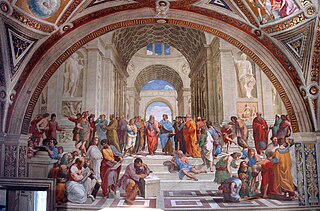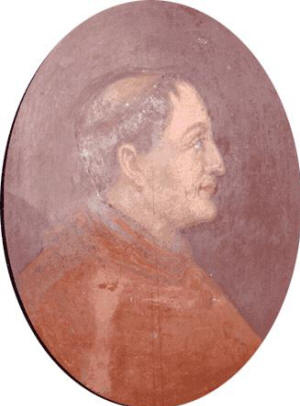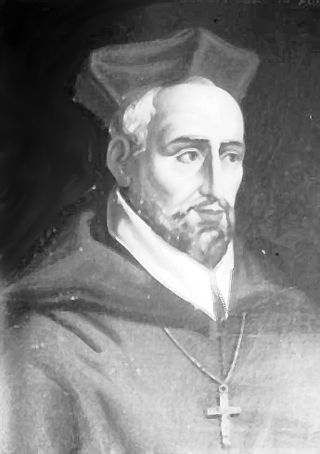This article relies largely or entirely on a single source .(February 2022) |
Antonio Ferrero (died 1508) (called the Cardinal of Gubbio) was an Italian Roman Catholic bishop and cardinal.

This article relies largely or entirely on a single source .(February 2022) |
Antonio Ferrero (died 1508) (called the Cardinal of Gubbio) was an Italian Roman Catholic bishop and cardinal.

Antonio Ferrero was born into a poor family in Savona. [1] As a youth, he was a squire of Cardinal Girolamo Basso della Rovere. [1] He then entered the service of Cardinal Giuliano della Rovere, the future Pope Julius II, who made him a protonotary apostolic and majordomo of the papal household. [1]
On 8 January 1504 he was elected Bishop of Noli. [1] He was consecrated as a bishop in the Vatican by Pope Julius II on 9 April 1504. [1] He was transferred to the see of Gubbio on 13 August 1504, occupying that see for the rest of his life. [1] He became Master of the Pontifical Household and Prefect of the Apostolic Palace. [1]
Pope Julius II made him a cardinal priest in the consistory of 1 December 1505. [1] He received the red hat and the titular church of San Vitale on 17 December 1505. [1]
On 23 January 1506 he was appointed papal legate in Perugia. [1] He was named Bishop of Perugia on 30 March 1506. [1] He also served as a pro-datary. [1]
On 20 February 1507 he was appointed papal legate in Bologna. [1] In Bologna, he had several inhabitants executed and extorted 30,000 gold ducats from the populace. [1] He also may have conspired to assassinate the pope. [1] As such, the pope recalled the cardinal to Rome in August 1507 and ordered the cardinal be imprisoned in the Castel Sant'Angelo. [1] He was subsequently fined 20,000 scudi and then imprisoned in the convent of Sant'Onofrio. [1]
He died in custody in Rome on 23 July 1508. [1] He was buried without ceremony in the Basilica di Sant'Agostino and his estates were sold in order to repay his victims. [1]

Pope Julius II was head of the Catholic Church and ruler of the Papal States from 1503 to his death, in February 1513. Nicknamed the Warrior Pope, Battle Pope or the Fearsome Pope, he chose his papal name not in honour of Pope Julius I but in emulation of Julius Caesar. One of the most powerful and influential popes, Julius II was a central figure of the High Renaissance and left a significant cultural and political legacy. As a result of his policies during the Italian Wars, the Papal States increased its power and centralization, and the office of the papacy continued to be crucial, diplomatically and politically, during the entirety of the 16th century in Italy and Europe.

Francesco Alidosi was an Italian cardinal and condottiero. He accompanied Giuliano della Rovere to France in 1494, and continued in favour when Della Rovere was elected pope, becoming Pope Julius II. Alidosi was elected as bishop of Mileto in 1504, and then transferred to the see of Pavia on 26 March 1505. He occupied the seat until his death in 1511.

Pope Julius II, commissioned a series of highly influential art and architecture projects in the Vatican. The painting of the Sistine Chapel ceiling by Michelangelo and of various rooms by Raphael in the Apostolic Palace are considered among the masterworks that mark the High Renaissance in Rome. His decision to rebuild St Peter's led to the construction of the present basilica.

Giovanni Antonio Sangiorgio was an Italian canon lawyer and Cardinal. Agostino Oldoino calls him the leading jurisconsult of his age. Kenneth Pennington has called him one of the ‘last two great commentators on feudal law’.

The Diocese of Gubbio is a Latin diocese of the Catholic Church in the province of Perugia, in Umbria, central Italy.
Federico di Sanseverino was an Italian Roman Catholic cardinal of the 16th century. Grandson of the Duke of Urbino, he spent most of his ecclesiastical career as a political operative, first for the Sforza in Milan, and then representing French interests. Most of his colleagues regarded him as a worldly man, more interested in pleasures, hunting and weapons, rather than prayer.
Amanieu d'Albret was a French Roman Catholic cardinal.
Pietro Isvalies was an Italian Roman Catholic bishop and cardinal.

Juan de Vera, known as the Cardinal of Salerno, was a Spanish Roman Catholic bishop and cardinal.

Giovanni Stefano Ferrero (1474–1510) was an Italian Roman Catholic bishop and cardinal.

Clemente Grosso della Rovere was an Italian Roman Catholic bishop and cardinal.

Galeotto Franciotti della Rovere was an Italian Roman Catholic bishop and cardinal.

Marco Vigerio della Rovere was an Italian bishop and cardinal of the Catholic Church.
Leonardo Grosso della Rovere was an Italian Roman Catholic bishop and cardinal.

Gabriele de' Gabrielli (1445–1511) was an Italian Roman Catholic bishop and cardinal.
Fazio Giovanni Santori was an Italian Roman Catholic bishop and cardinal.

Sisto Gara della Rovere, also known as Sisto Franciotti della Rovere, was an Italian Roman Catholic bishop and cardinal.

Achille Grassi was an Italian Roman Catholic bishop and cardinal.
Esteban Gabriel Merino was a Spanish Roman Catholic bishop and cardinal.

Niccolò Bonafede was a Roman Catholic prelate who served as Bishop of Chiusi (1504–1533).